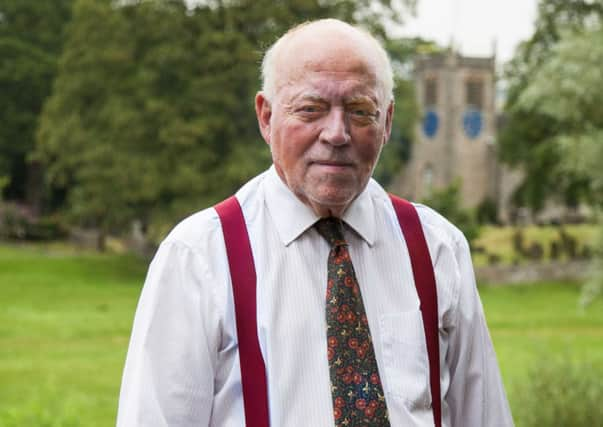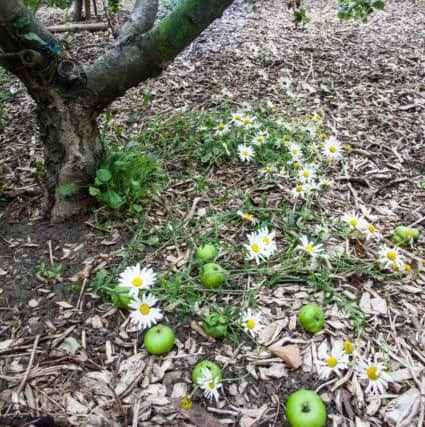How a labour of love proved so fruitful


As we stroll through the beautiful Church Orchard, Addingham on a fine summer’s day, Derek Law says: “I will have every insect and wasps’ nest going in my orchard. I particularly love wasps because they eat greenfly larvae. Insects are so important to the life of an orchard. They are pollinators and pest control all rolled into one.”
Over the best part of two decades Derek has painstakingly created an orchard inspired by the Reverend Gilbert White, the celebrated 18th century clergyman and naturalist who not only recorded the Natural History of Selbourne, in Hampshire but grew fruit to feed his poor, malnourished parishioners.
Advertisement
Hide AdAdvertisement
Hide AdThe 75-year-old antiquarian book valuer got the idea for establishing the orchard on an acre of derelict land abutting St Peter’s Church when he discovered an original handwritten copy of Gilbert White’s Garden Kalender, in the British Library. White’s “Kalender” is a horticultural diary describing the extraordinary fruit and vegetables grown in his parish orchard between 1751 and 1768.


At the time White was writing, the British Isles were experiencing a little ice age but despite long, cold freezing winters his orchard in Hampshire contained the very best soft fruit including blackberries and blackcurrants as well as top fruit such as apricots, plums, pears and apples. He experimented with a cold frame which sat on a pile of hot manure to grow “Cantaleupe” melons and cucumbers. White also recorded the humorous antics of his pet tortoise, Timothy, who loved foraging in his asparagus beds.
“White was picking his first cucumbers in the second week in April and melons from the middle of May. We can’t do that today. What he achieved then was extraordinary,” says Derek. “I just thought it would be interesting to see if I could create a similar parish orchard here in Addingham which is about the same size.”
The Church Orchard project began in 1986 when the land became available and Derek went fishing in the nearby village of Kilnsey with his friend the late BBC Gardener’s World presenter Geoffrey Smith.
Advertisement
Hide AdAdvertisement
Hide Ad“I said to Geoffrey, I have got this great project. I really want to put this orchard in. And he said to me he thought the project was a great idea but knew how limited my knowledge of gardening was at the time. He gave me the only two pieces of advice he said I would ever need. Firstly, always buy bare rooted stock; never buy a fruit tree in a pot and second, put the brown end in the soil, the green end above it and you’ll be in with a much better chance.
“The Church Orchard is not a perfect location for growing fruit as it has a steep north facing slope leading to a flat area which becomes very cold on clear spring evenings. The wind tends to blow over the top of the trees which is good and it does have great topsoil because the plot had been used for keeping sheep, chickens and pigs.”
The land, which belongs to St Peter’s church, is bounded by a beck to the north and Church Street to the south. The beck and its banks are a great asset because they have a variety of trees which have extensive root systems which prevent the erosion of the bank. There are a number of early flowering willows which carry marvelous quantities of silver catkins which puff out into yellow pollen filled globes in early spring and attract both pollinating and predatory insects which is vital for the orchard to produce fruit.
The orchard is carefully managed to encourage insect life once it has arrived to stay in the orchard. Log piles are in place to house beetles and bugs which provide food for nesting birds which are essential for keeping pests under control. The floor of the orchard is extensively planted with spring bulbs. Drifts of snowdrops spread across the orchard in February and March and crab apples have been planted to help pollinate adjacent apple trees.
Advertisement
Hide AdAdvertisement
Hide Ad“There was no initial plan for the design or layout of the orchard – it simply evolved. The general idea was to grow a similar range of fruits to those grown by the Reverend Gilbert White in his orchard in Selbourne. Apples form the nucleus of the top fruit and we have 32 different varieties. Some of my best apples are named after the clergymen who bred them including Reverend W Wilks, Ellison’s Orange and Tom Putt, a lovely cider apple that can also be used for cooking. I have planted 10 varieties of pears, 14 varieties of plums and damsons, and four varieties of hazelnuts together with quinces, medlars, apricots and sweet chestnuts. Each year I try out new varieties. Last year we planted five new apple trees. All the top fruit has been selected to provide a mixture of dessert and culinary fruits which crop from early August until October, with stored fruit extending well into the New Year.”
As we walk round the orchard I can see the top fruit is under planted with a wide range of soft fruits including rhubarb, raspberries, currants, gooseberries, loganberries, Tayberries, strawberries and blueberries.
“In the 18th century people wanted different apples to those eaten today. For one thing their teeth were not strong enough to eat the hard, crunchy apples we like today. Men always used to carry a penknife to peel and cut their daily apple” Derek tells me.
Apples used to be grown for flavour rather than texture and good looks. Two hundred years ago fruit had become a rarity in the diet of most people because orchards had come under attack from the cold winter weather that blew in from Eastern Europe and the agricultural revolution which diverted resources away from growing fruit to growing cereals and raising dairy cattle which were more profitable.
Advertisement
Hide AdAdvertisement
Hide AdRoyalty and the nobility all enjoyed fruit which they either grew or imported. Ships filled with fine English wool went to European North Sea ports and returned with seasonal fruits like oranges, lemons, pomegranates and dates but the majority of poor, country people lost their fruit harvest. The damage done to the health of rural communities by the lack of fruit in the diet was first noticed by the clergy in country parishes who saw firsthand the decline in the health of their parishioners and the increased number of early deaths. It was this that led White and other clergymen to establish parish orchard to feed and nourish the poor.
“Gilbert White’s journal is the only surviving record of an original parish orchard and extracts have been published as a book which we can read today,” says Derek. “It is an inspiring read because it tells us how the environment has changed. In one entry of August 8 he writes, ‘we have shot 31 blackbirds and saved our gooseberries’. Imagine a garden with 31 blackbirds in it? You would never see that many blackbirds in a garden today.
Derek admits it’s difficult to know exactly how much fruit the orchard produces. It is somewhere in the region of three and a half tons of apples and a half a ton of pears as well as a lot of soft fruit and as we’ve become accustomed to supermarket produce he does have problems disposing of some of his harvest.
“In the past when food was short, people would eat fruit that was misshapen and slightly blemished. You would never see windfalls rotting beneath trees. These days when I take all these glorious fresh apples over St Peter’s Church for people to help themselves on Sundays they are not always keen to take apples that have a few blemishes. Children as so used to seeing perfect apples from supermarkets they are reluctant to eat mine. Outside the Box community café in Ilkley press the apples to make juice and volunteers who help me in the garden take some. Although lots of people volunteer to pick the top fruit it is quite hazardous getting it down from the tall trees.”
Advertisement
Hide AdAdvertisement
Hide AdDerek advises storing apples in cool, slightly humid conditions.
“In the past people used to live in cold damp houses and stored apples on racks under the bed. These were perfect conditions for keeping apples through the winter.”
The time and dedication Derek has lavished on this orchard over the years is something to behold. The trees are carefully pruned, the orchard is well managed and he even showed me a copy of his own handwritten garden calendar in which he has entered a weekly diary of everything he has done in over the last 18 years. It is a beautifully bound thing of beauty, but he is also concerned about the future.
“I will work on the orchard for as long as I am able to and I hope someone will take it on after that but it does take a lot of work and it is difficult to run it by committee.”
Advertisement
Hide AdAdvertisement
Hide AdFor now though he is content to continue what has clearly been a labour of love and this year, as ever other, there is one particular crop he is most looking forward to sampling. “My favourite apple? Undoubtedly it is the Pitmaston Pine Apple which is about the size of a toddler’s fist. It has a yellow skin and when it comes off the tree in the autumn it is as hard as a bullet. Leave it to mature until Christmas and the flesh softens. Cut into it and it smells like honey and tastes like pineapple which is like nothing else you have ever tasted”.
Last year Derek gave me three of his special Pitmaston Pine Apples which I kept in the cellar until December. On Christmas Day I tried one. Derek was right – it was probably the best apple I had ever tasted.